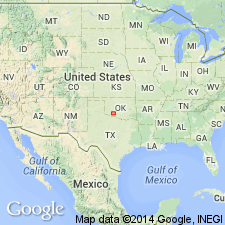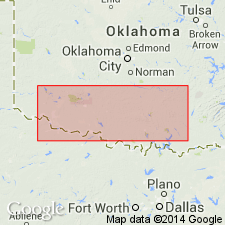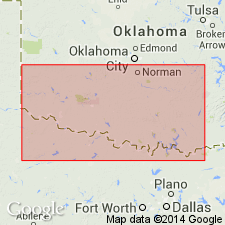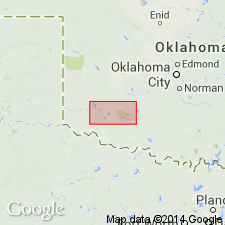
- Usage in publication:
-
- Raggedy Mountain gabbro
- Modifications:
-
- Original reference
- Dominant lithology:
-
- Gabbro
- AAPG geologic province:
-
- South Oklahoma folded belt
Summary:
Pg. 135, 136. Raggedy Mountain gabbro. Gabbro, including a considerable variety of basic rocks regarded as facies of one magma. Possibly eruptive through Carrollton Mountain porphyry. Assigned to Archean(?).
Named from Raggedy Mountains, Kiowa Co., southwestern OK.
Source: US geologic names lexicon (USGS Bull. 896, p. 1764).

- Usage in publication:
-
- Raggedy Mountain group
- Raggedy group
- Modifications:
-
- Areal extent
- Dominant lithology:
-
- Gabbro
Summary:
Pg. 56-57, geol. map. Raggedy Mountain group; Raggedy group. Mounds and low-rounded knobs of pre-Cambrian gabbro called Raggedy Mountains, between the Red River and Wichita Mountains, Kiowa County, Oklahoma. Notable exposures east and southeast of Roosevelt on both sides of Otter Creek, in gorges of the Upper and Lower Narrows.
Source: Publication.

- Usage in publication:
-
- Raggedy Mountain Gabbro Group
- Modifications:
-
- Age modified
- Geochronologic dating
- Dominant lithology:
-
- Gabbro
- Anorthosite
- Diorite
- AAPG geologic province:
-
- South Oklahoma folded belt
Summary:
Raggedy Mountain Gabbro Group. Layered and laminated rocks composed chiefly of diallage gabbro, anorthosite, olivine gabbro, troctolite, and quartz diorite. Uppermost 1,000 feet exposed in Wichita Mountains; as much as 8,000 feet has been drilled in one well without reaching base. Intrusive equivalent of Navajoe Mountain Basalt-Spilite Group (new). Intruded by Wichita Granite Group (new); intrudes Tillman Metasedimentary Group (new) as a concordant lens. Age is Early(?) Cambrian based on Rb-Sr age of 535 Ma.
Recognized in Wichita Mountains area, Kiowa and Greer Cos., OK.
Source: GNU records (USGS DDS-6; Denver GNULEX).

- Usage in publication:
-
- Raggedy Mountain Gabbro Group
- Modifications:
-
- Revised
- AAPG geologic province:
-
- South Oklahoma folded belt
Summary:
Divided into the newly named Glen Mountains Layered Complex and the newly named Roosevelt Gabbros. Mapped (geologic map) in the Glen Mountains of Kiowa Co and in the Wichita Mountains of Comanche Co, both in OK in the South Oklahoma folded belt province. Glen Mountains Complex divided into the (ascending[?]) G, K, L, and M zones [informal designations]. Roosevelt Gabbros divided into the (ascending[?]) Mount Sheridan (new), Sandy Creek, and Glen Creek Gabbro Members. Stratigraphic table. Of Cambrian age.
Source: GNU records (USGS DDS-6; Denver GNULEX).
For more information, please contact Nancy Stamm, Geologic Names Committee Secretary.
Asterisk (*) indicates published by U.S. Geological Survey authors.
"No current usage" (†) implies that a name has been abandoned or has fallen into disuse. Former usage and, if known, replacement name given in parentheses ( ).
Slash (/) indicates name conflicts with nomenclatural guidelines (CSN, 1933; ACSN, 1961, 1970; NACSN, 1983, 2005, 2021). May be explained within brackets ([ ]).

